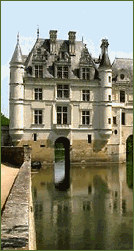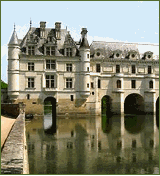|
Fontainbleau Chateau was home to Napoleon I and this 16th century
royal chateau is on the site of an ancient hunting lodge and is much older than Chateau de Versailles plus bears the marks of each
monarch and emperor who has lived in its walls.
Attracted notably by the immense surrounding forest full of game, Francois I decided in
1527 to enlarge what was then just a modest fortified chateau, making it one of the most
prestigious royal residences and one of the jewels of French art, as much for its
architecture as for its decoration and gardens.
It's conveniently located right in the centre of the town of Fontainebleau, and its
gardens and large park are free to the public. You will find the chateau a nice
alternative to seeing Versailles, with fewer crowds and more actual history, plus part of
the chateau houses the Napoleon Museum.
So for a relaxed day away from the city of Paris,
get into the forests of Fontainebleau. The
forests are perfect for hiking, trekking, biking and horseback riding, plus by visiting
the nearby charismatic town of Fontainbleau, which is home to a gigantic castle with
widespread grounds, you will have a pleasant day that all the family will remember.
The town of Fontainebleau is worthy of a potter
round, with some interesting architecture and, of course, a multitude of souvenir shops
plus some quaint and attractive shops, which add to the atmosphere of this town.
But, the main tourist attraction of Fontainebleau is the stately chateau that dominates
the town and with it being easily accessible and parking convenient with an underground
car park adjacent to the chateau, this could well be a great place to explore, whilst on
holiday in the Ile De France region or whilst visiting
Paris.
The formal gardens are massive, but if you cannot walk for too long, then there is a
horse-drawn carriage that stands by ready to give you a tour of the estate.
Peacocks also roam freely in some areas of the grounds, which really does add to the
appeal and beauty of the exceptionally well-kept gardens.
Also preserved on the grounds is King Henry IV's jeu de paume (real tennis court), which
is said to be the largest such court in the world.
Yet if you have children or just enjoy feeding fish yourself, then you will not want to
miss the carp pool, which actually started off life as a swamp pool, but Francois I had
this converted into a lake, which was populated with fish for the royal table.
Obviously, they are not eaten these days and the large fish really do go crazy over the
food thrown in by the visitors.
In the middle of the lake you can see the royal pavilion, which was first built under King
Henri IV, then rebuilt by King Louis XIV, and then restored by Napoleon I. You could
just picture stepping back in time with royalty in their finery taking walks in the fine
gardens and having afternoon tea admiring the beautiful gardens that have been superbly
kept, just as King Louis wanted.
The Royal Chateau of Fontainebleau is one of the largest French royal chateaux and today
you can see the work of many French monarchs that built upon an original structure by
Francis I. The building is arranged round a series of courts and Francois I, King
Henry IV and Napoleon all had an individual entrance built.
Philip the Fair, Henry III and Louis XIII were all born in this grand chateau.
And besides being one of the most important royal palaces throughout the 16th and 17th
centuries, it is also an exquisite example of French Renaissance architecture.
Yet this chateau is so rich with history, we have the feeling that we could spend years
studying this place, and still not even begin to fully understand it's long history!
|
|



